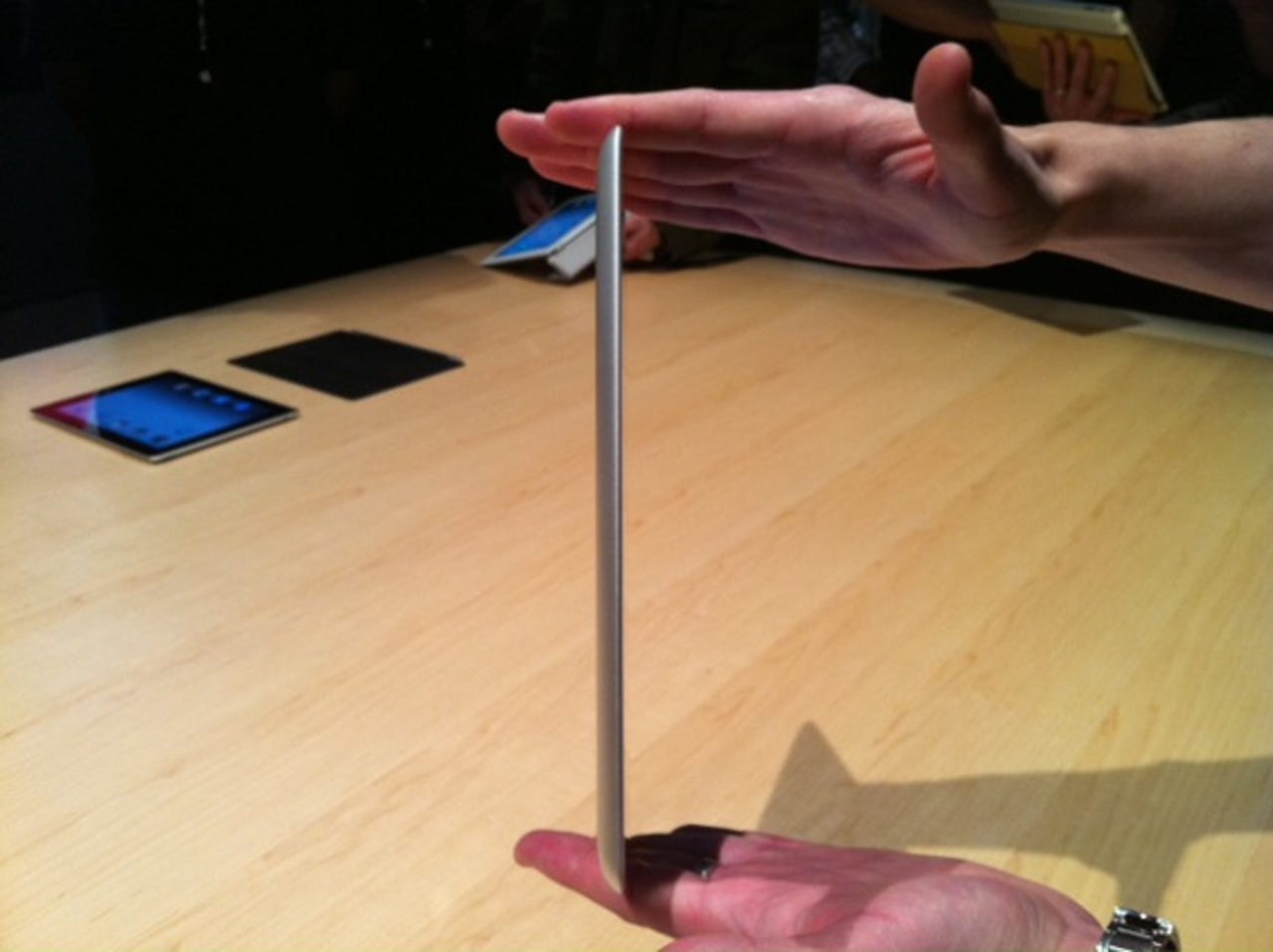Apple iPad 2, PlayBook, robots and CeBIT tech


Photos of the month - March 2011...
After months of rumour and speculation, Apple finally put gadget commentators out of their misery by lifting the curtain on the second generation of its iPad tablet. The main difference the iPad 2 brings? It's much thinner than Apple's first tablet - a mere 8.8mm versus the original iPad's 12.7mm. It's also faster than the original, with a dual-core 1.2GHz processor.
But by far the biggest surprise of the iPad 2 launch was the appearance on stage of Apple's CEO Steve Jobs who is currently on medical leave from Apple. "We've been working on this product for a while and I just didn't want to miss today," he said.
For snaps of Apple's iPad 2 from the launch event, see Photos: Apple iPad 2 unveiled by Steve Jobs.
Apple also launched dedicated screen covers for the iPad 2, which attach to the device via magnets to protect the screen from damage. The so-called smart covers can also be folded to prop the iPad at a handy angle for typing, as shown above, and for video viewing.
To see more photos from the UK launch of the iPad 2, see Photos: Apple iPad 2 UK launch in pictures.
Apple may be ruling the tablet roost for now but the challengers to the iPad are lining up. Last month, BlackBerry maker RIM was showing off its PlayBook tablet, pictured above.
The PlayBook has not yet launched but is due this year. RIM will be hoping the small slate's charms are enough to persuade BlackBerry users to keep it in the family, rather than defecting to Apple or Android. For more pictures of the PlayBook, see Photos: BlackBerry PlayBook - hands-on with RIM's tablet.
Six iPad challengers - including RIM's PlayBook - were rounded up in this popular feature last month. Google's Android platform looks likely to be Apple's biggest competitor with Android slates lining up - from makers including HTC, Motorola and Samsung.
HTC's Android-based Flyer tablet is pictured above.
For more iPad alternatives, see Photos: Six iPad alternatives.
Last month, Microsoft gave a sneak peek of some of the research projects that are seeking to push its Kinect gesture-based gaming peripheral into a fully fledged collaboration tool.
Pictured above is a project called mirage blocks, which uses a Kinect-style camera and natural user interface coupled with a 3D projector to render real objects digitally in 3D space. The resulting projection could enable remote workers to collaborate together on a project.
To see more photos of the R&D projects, see Photos: Microsoft Kinect pushes natural UI frontier.
Meanwhile, silicon.com got a behind-the-scenes look at how Microsoft engages with UK customers looking to invest in its current technology.
The Microsoft Technology Centre at the company's UK headquarters in Reading features an envisioning room, shown above, containing various products and a number of big screens that Microsoft staff use to demonstrate software.
For the other ways customers can try out Microsoft technology in action, see Photos: Microsoft Technology Centre behind-the-scenes tour.
At the CeBIT 2011 conference in Hanover, silicon.com got hands-on with the Ford Sync, an in-car voice-controlled computer system.
As well as using their voice to control the system, drivers can use the five-button panel on each side of the steering wheel to browse through the Ford Sync menus.
Explore the features that the Ford Sync has to offer by visiting Photos: Ford's voice-controlled car goes on show.
Here is a cool concept for a future PC that was being shown off by Asus.
The PC maker showed its vision of Iris - Inspirational Research for Immersive Space - a stretchable transparent screen that could act as anything from a wristwatch to a tablet computer.
To see more of Iris and pictures of Asus' latest Google Android Honeycomb tablets, check out Photos: Asus screen tech and latest tablet line-up.
Increasingly ingenious ways of interacting with technology were on show at CeBIT 2011.
This is an interactive shop window with a gesture-recognition system that allows shoppers to point at products on display to view more detailed 3D models of the items on a screen and call up product information.
Check out more futuristic control interfaces by browsing Photos: Gesture controls, eye-tracking tech and facial recognition.
Aerospace and defence company EADS also had some research tech to show off last month. Pictured above is Airbike, a bicycle created using a manufacturing process that involves growing parts from high-strength nylon powder via a technique called additive-layer manufacturing (ALM).
The company believes ALM could revolutionise manufacturing processes by doing away with the need for production lines and factories.
For more on Airbike, see Photos: EADS Airbike, the bike that's grown not made.
Google introduced new features to Google Docs so people working on documents can discuss changes and developments using a conversation stream that runs alongside the document.
When people are added to the discussion they receive an email with a link to the document so they can easily contribute - as shown above.
To see exactly how the collaboration tech works, check out Photos: Google Docs get chatty.
silicon.com visited the University of Essex in March to have a look at some of the machines at the university's robot testing lab.
In the university's robot arena, researchers test out a variety of kit, from flying robots that track objects on the ground to mobile machines that mimic human behaviour.
This is Rex - a robot that displays elements of lifelike behaviour, using an artificial-intelligence routine.
To discover more of the university's robots, check out Photos: Inside a robotics testing lab.
Microsoft released the latest version of its Internet Explorer web browser in March and silicon.com was on hand to examine its new features.
Here you can see how Internet Explorer 9's interface has been minimised to reduce clutter and maximise space for a website or app.
To explore more of Internet Explorer 9's features, check out Photos: Internet Explorer 9's new features.
There were robots galore at this year's CeBIT show.
silicon.com rounded up some of the most interesting bots, including the Gostai Jazz telepresence robot seen here.
The robot has a maximum speed of 4km/h and is controlled via a web browser interface over the internet.
To find out more about the robots of CeBIT 2011, visit Robot photos: AI androids to footballing humanoids.
This is a view inside the beta version of the app store for SAP's Business ByDesign, its software-as-a-service ERP product.
The SAP Store will provide a marketplace where apps and other add-ons can be bought to enhance the functionality of Business ByDesign services.
Continue the tour of SAP's beta version of the Business ByDesign app store and learn about its features by visiting Photos: Inside SAP's cloud app store.
Another slice of technology from the show floor at CeBIT 2011, this time rounding up everything from the latest Windows Phone 7 handsets to Google Android Honeycomb tablets.
This is MSI's Windpad 100A tablet PC, which will run Android Honeycomb when it launches in the UK in the second half of this year.
The tablet is based on the Nvidia Tegra 2 chipset, which will allow it to play back 1,080-pixel HD video on its 1,280 x 800-pixel screen.
Check out the rest of the tech on show at CeBIT by visiting Photos: Honeycomb tablets, ebook readers and smartphones at CeBIT.
HP revealed its revamped EliteBook and ProBook range, which has been updated to make the laptops more durable.
The ProBook b-series, above, now comes in a tungsten-coloured case and is available with a 13.3-inch, 14-inch or 15.6-inch screen.
Check out more of the tougher laptop range, in Photos: HP business laptops toughen up.
Data-recovery specialist Kroll Ontrack unveiled photos of some of the most ravaged pieces of computer hardware from which it has retrieved information.
silicon.com showed the damaged pieces of hardware - everything from smashed hard disc platters, seen here, to rusted hard drives.
Check out more shots of hard drives on the brink of destruction, in Photos: Rescuing data from fire, water, 12-storey falls.
The UK release of the Apple iPad 2 in March caused queues outside Apple's flagship London store. Some people waited more than 24 hours to get an iPad.
Catherine Cheng, front, planned to buy a pair of iPad 2s to sell them to friends. She'd been in line since 7.30am on March 25, and nine hours later, the sun was setting.
See photos of more queuing madness by visiting Photos: iPad 2 queue in London.